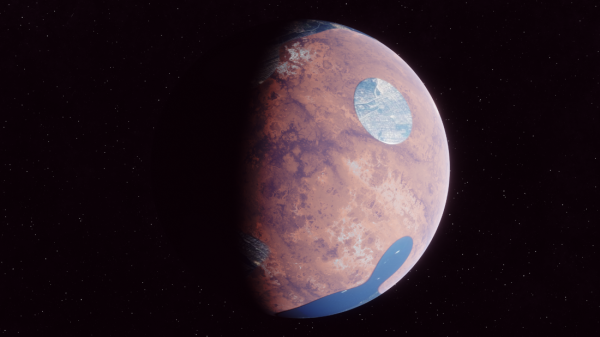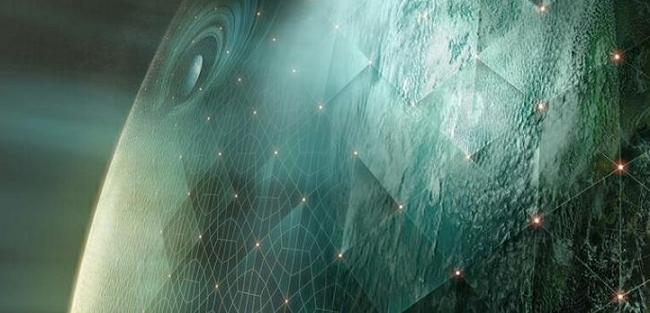BY LETTER
Worldhouses
Technology > Technology Type or Material > Drytech/Hylotech
Technology > Technology Levels > High Tech / Hitech
Technology > Application > Infrastructure
Technology > Application > Megascale Engineering
Technology > Technology Levels > High Tech / Hitech
Technology > Application > Infrastructure
Technology > Application > Megascale Engineering
Relatively thin membranes designed to retain atmospheres on volatile-poor planets | |
 Image from Tasp | |
| A partial worldhouse on the surface of Maakra, a volatiles-poor but otherwise resource-rich EuArean world in the Excelsior system. Praasr Worldhouse can be seen in the northern hemisphere and the enclosed Kirasukara Ocean in the southern. The region of paraterraformed surface was planned to be extended to cover the entire planet, but plans were stalled, and later abandoned, due to the system's disruption by a local transcension perversity. | |
Worldhouse terraforming is a technocentric approach that is capable of terraforming nearly any rocky world, usually worlds with minimal atmosphere to begin with. The Bluesky Megacorp is credited with the early development of the worldhouse concept, creating transparent atmosphere roofs over a large number of worlds in the Inner Sphere and Middle regions.
In most cases the worldhouse structure is quite simple; a tough, flexible transparent roof that admits sunlight and prevents atmosphere escape. Most worldhouse roofs are largely supported by atmospheric pressure, but may be supported by support columns as required. Modern worldhouse roofs are largely self-repairing, capable of dealing with small to medium meteor impacts; such roofs generally consist of several layers, some of which are filled with smart fluids or gel which actively repair any minor punctures.
 Image from Copyright Chris Wren used with permission | |
| A Worldhouse Roof covering Arby, a low gravity moon of the gas giant Hawksmore, which can be seen reflected in the surface. | |
Biologically grown worldhouse canopies come in many forms, such as canopy plants, greenbubbles, and Yggdrasil bushes.
One common form of worldhouse is that used by the Deeper Covenant, described in the next section
Deeper Covenant Worldhouses
The Deeper Covenant have developed an interesting variant on the worldhouse concept which allows a habitable surface to be established on an object far from any main sequence star. Due to the fact that its members live mainly around brown dwarfs the Deeper Covenant needed a different approach to terraforming than that used in star systems. Over time Deeper Worldhouses evolved into the advanced form described below. Through trade and contact with various worlds the concept, templates, and designs quickly spread from the beamrider network to the Wormhole Nexus. Benedita Bluesky eventually adopted the Deeper Covenant Worldhouse and began using it almost exclusively in later projects. This type of worldhouse makes it possible to fully terraform worlds around nearly any stellar object, and has become a popular design choice outside of Covenant territory.The first step in the building of this type of worldhouse is to determine the quantity of volatiles a planet has. Some worlds may have too much or two little of a give element for proper terraforming. Once this is done, figuring out what volatiles to add and what volatiles to remove is the next step.
Next six towers are built on the planet. These towers are roughly 25 kilometres in height and are located at six points on the planets surface. One tower at is built at each pole and another at four points on the planet's equator. One or all of the towers are used as a base of operations for the terraforming project. They also serve as a framework for a magnetic orbital launch system or as the anchor for a space elevator. The polar towers though cannot be used for space elevators and some worlds rotate too slowly to make space elevators economical.
Once the towers are built the process of removing or adding volatiles begins. Nanites combined with large compressors and other structures in the tower begin releasing volatiles trapped in the rocks or converting excess atmospheric gases into inert solids that are buried or launched into space. During this process the surface of the planet be re sculpted to create ocean basins and continents if such formations do not naturally exist. If the volatiles aren't found on the planet itself, asteroids and comets are diverted into the planets orbit. Orbital factories grind the chunks of various ices into smaller chunks and sent into orbits which cause them to rain down on the planet as micrometeorites. This approach prevents many of the problems that follow from large-scale cometary or asteroidal bombardment. Low gravity worlds require an orbital shade during this part of the process to prevent sunlight from boiling off the newly acquired volatiles. Other worlds may need the sunshade to help cool the atmospheric temperature.
Once the volatiles are balanced the construction of the worldhouse roof begins. Large hydrogen balloons are used to raise 25 km long tethers of buckytube cable above the planets surface. These cables will serve as anchors for the worldhouse roof, which will be held up by hydrogen or helium filled cells combined with atmospheric pressure from the planet. The cables are often 50-75km apart. Automated, high speed, and lightweight airships are then used to connect the individual tethers to the towers with thin buckytube cables. Once this web is completed robots begin climbing the towers weaving a denser web between the towers and the tethers. This denser web is the covered in a clear hydrocarbon self-healing polymer. Flexible hydrogen filled cells are then attached to the web starting at the towers. These are held in place by the buckytube reinforced polymer roof, which seems to grow from the six towers. A second layer of buckytube reinforced is placed on the bottom of the hydrogen cells creating a flexible self-supporting roof that covers the entire planet.
Next nanites begin to grow thin lightweight flexible solar cells on the outer side of the worldhouse roof. These solar cells completely block the planets surface off from light. Some worldhouse roofs are covered in flexible rectenna that covert beamed microwave energy into electricity. While the rectenna or solar cells are coating the top of the world house roof a second series of helium filled cells are being attached to the underside of the roof. These cells have full spectrum lights at that are suspended in the cells core. These are what create the light for the terraformed planet. The undersides of the helium filled cells are made of a light-diffusing polymer, which spreads out the high intensity light creating gentler glow. The light can be turned on, off or varied in intensity as needed.
At this point the planet is seeded with life. The towers begin pumping out a breathable atmosphere and the helium light cells begin to warm the planet.
Orbital mirrors may be used to reflect more sunlight onto the solar cells, which provide the majority of the power needs of the colony as well as the lighting system of the planet. Beamed energy from fusion power planets in the atmosphere of jovians and brown dwarfs provide the power for the rectenna covered worldhouse roofs.
The entire worldhouse roof has a mild electromagnetic field that helps in radiation protection. The interior light is varied to create a day and night cycle as well as to control climate. By varying the amount of heat reaching the surface at various points the climate can be changed to suit the needs and desires of the populace. The main population centers tend to be the six towers. The towers are often used for industrial, residential, and commercial applications as they are the entry and exit points of the worldhouse roof.
The Deeper worldhouse can be used to terraform practically any minor planet or planetoid. The world's climate can programmed and is totally independent of the planet's rotation or orbit. The structure is self-healing and maintaining and can be considered a living nanite structure. Not only does the worldhouse roofs provide habitable conditions on nearly any planet but also provides abundant energy via the worldhouse outer covering.
Worldhouses in their various forms are widely used wherever smaller planets, planetoids and other objects are available for colonisation, or sometimes as a quick intermediate stage before full terraformation can be achieved.
Related Articles
Appears in Topics
Development Notes
Text by James Ramsey
Initially published on 28 July 2003.
Initially published on 28 July 2003.






